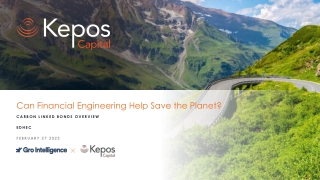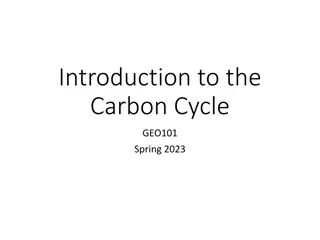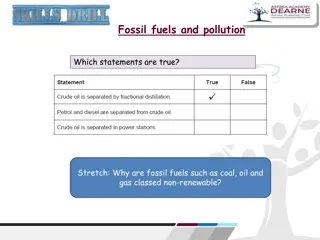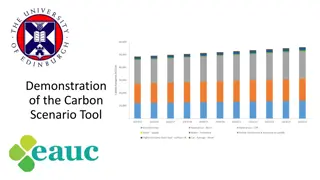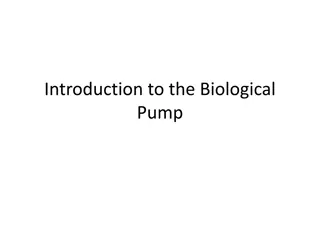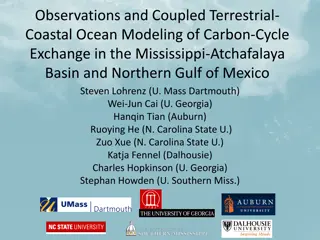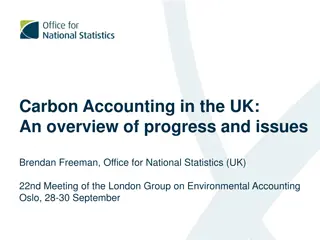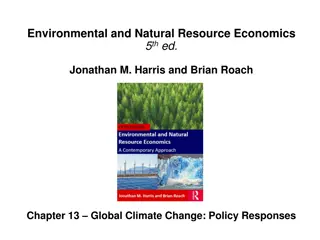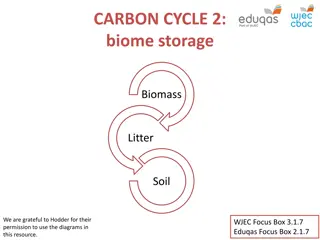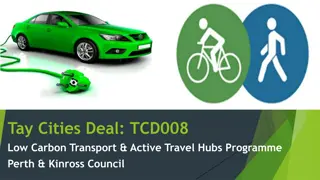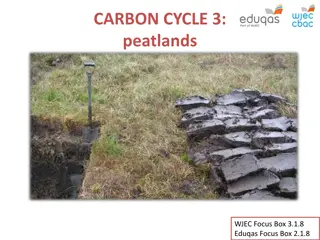Insights into Low-Carbon Lifestyles and Modeling Change
Conducting a large-scale review of literature on lifestyles revealed key insights for low-carbon research, spanning health, marketing, and environmental domains. Through the development of a conceptual framework and empirical application across four countries, the interplay between cognitions and behaviors in specific contexts was analyzed to define low-carbon lifestyles. Utilizing a robust analytical framework, the LIFE Model identified four distinct lifestyle types - Resourceful, Active, Constrained, and Cautious - with variations in low-carbon behavior and cognitions. The model further extrapolated these findings to predict lifestyle changes in multiple countries, emphasizing the importance of contextual enablers or constraints.
Download Presentation

Please find below an Image/Link to download the presentation.
The content on the website is provided AS IS for your information and personal use only. It may not be sold, licensed, or shared on other websites without obtaining consent from the author.If you encounter any issues during the download, it is possible that the publisher has removed the file from their server.
You are allowed to download the files provided on this website for personal or commercial use, subject to the condition that they are used lawfully. All files are the property of their respective owners.
The content on the website is provided AS IS for your information and personal use only. It may not be sold, licensed, or shared on other websites without obtaining consent from the author.
E N D
Presentation Transcript
DELIVERABLE 1 Review of the Literature on Lifestyles
We conducted a large scale review of the literature on lifestyles to gain insights for low-carbon research large scale (directed) review range studies conceptual studies, empirical studies across key domains health and wellbeing, marketing and consumer behaviour, low carbon / pro-environmental global reach Figure 1(a) Studies by type Figure 1(b) Studies by region
Deliverable 2 (1) Development of Conceptual Framework and Empirical Application to Four Countries
Figure 2 - Analytical Framework for Low-carbon Lifestyle We define lifestyle as We define lifestyle as the interplay between cognitions and the interplay between cognitions and behaviour in specific material and social contexts behaviour in specific material and social contexts
We measure low-carbon lifestyle using large scale social survey data Share of Sample Lifestyle type hierarchical cluster analysis Resourceful identification 22% Large scale social survey data (UK, China, USA, Australia) N=15,900 2010 - 2018 The LIFE model Active 30% Constrained 27% Cautious 21% Share of population National Geographic Greendex Survey (2009 and 2014) World Values Survey (2010 2015) World Bank (2018) Global Competitiveness Index (2018) Resourceful 25% extrapolation shaping parameters Active 36% Constrained 21% The four lifestyle types are extrapolated to 18 countries Cautious 18% Figure 3 Measuring and extrapolating low carbon lifestyles
Deliverable 2 (2) Modelling Low-Carbon Lifestyle Change The LIFE Model
The LIFE Model: Summary Strong empirical basis (national statistical surveys from 4 countries) (N=15,600) Four types Resourceful , Active , Constrained , Cautious . Characteristic (mean) scores on low-carbon behaviour and low-carbon cognitions Within-cluster variation explained by contextual enablers or constraints which vary by type Extrapolation functions predict cluster size and characteristics for n countries Position of each clusters on low-carbon behaviours is a function of A- S-I behaviours (data from National Geographic, Greendex Survey, 18 countries) Figure 4 The LIFE Model Schematic (1) Position of each cluster on low-carbon cognitions is a function of perceived behavioural control, long-term value orientation, life satisfaction and environmental beliefs (data from World Values Survey, 100+ countries)
Drivers of Low-Carbon Lifestyle Change Path (a) contextually-driven lifestyle - lifestyles shift as context becomes more enabling or constraining. Path (b) cognitively-driven lifestyle - lifestyles reflect self-expression, personal ideology, and a sense of identity. Path (c) behaviourally-driven lifestyle - lifestyles also shift in response to familiarity with behaviours (and technologies). Figure 5 The LIFE Model Schematic (2): Drivers of Low-Carbon Lifestyle Change. Upper panel (a) shows the opportunity effect , driven by change in context. Middle panel (b) shows the identity effect , driven by change in cognitions.
Coupling LIFE Model to a global IAM Figure 6 The LIFE Model Schematic (3): Generic Soft-Coupling with Global IAM
Test Implementation in a Single End-Use Sector Coupling LIFE and MESSAGEix-Buildings
Coupling LIFE and MESSAGEix-Buildings (proof of concept) Iterative feedbacks between the LIFE and MESSAGE translate static characterisation of lifestyle heterogeneity and lifestyle change mechanisms in the LIFE model into a dynamic simulation of lifestyle change in MESSAGE. 1 - Lifestyle clusters size (11 regions) - Behavioural propensity modifiers (global) We run two scenarios MESSAGEix- Buildings LIFE Model 6 7 5 SSP2+LIFE introduces the LIFE model coupling to MESSAGEix- Buildings to evaluate the effect of endogenizing heterogeneous low- carbon lifestyles and distinct mechanisms of lifestyle change. 2 Iterative coupling Four lifestyle types with distinct low-carbon cognitions and behaviour Modifiers affect energy efficiency decisions 3 4 SSP2+LIFE+Values compares the effects of endogenizing low- carbon lifestyle and heterogeneous lifestyle change with and without an additional assumption of enhanced strong cognitively-driven lifestyle change ( Identity effect). Changes in energy demand (low carbon behaviour) Exogenous forcing Scenario narrative Changes in external context Figure 7 Seven Step Coupling Approach (developed with MESSAGEix_Buildings)
Key Finding 1: Drivers of lifestyle change distinguish between demand across energy-efficient behaviours Figure 8(a) Figure 8(b) SSP2+LIFE Figure 8(c) SSP2+LIFE+Values
Key Finding 2: Simulated cognitive shifts under SSP2+LIFE+Values reduces final energy intensity in the disengaged types. Figure 9. Reduction in Final Energy Intensity for Space Heating by Lifestyle Type comparing SSP2+LIFE with SSP2+LIFE+Values
Key Finding 3: Drivers of lifestyle change also distinguish between demand in total energy. Figure 10. Projections of Total Final Energy Demand for Space Heating by Lifestyle Type comparing Baseline (SSP2) with SSP2+LIFE and SSP2+LIFE+Values , for the years 2015, 2030 and 2050.
Four Main Discussion points 1. We advance conceptual reasoning and methodological practice beyond the conventional approach to lifestyle change in global IAMs 2. The LIFE model has strong empirical foundations and uses robust methodological approaches for characterising lifestyle heterogeneity and estimating lifestyle change dynamics 3. Our approach specifically addresses criticisms of the framing and lack of representation of lifestyle heterogeneity and lifestyle change in global IAMs 4. The LIFE model is versatile and adaptable for soft-coupling with different IAM frameworks.


